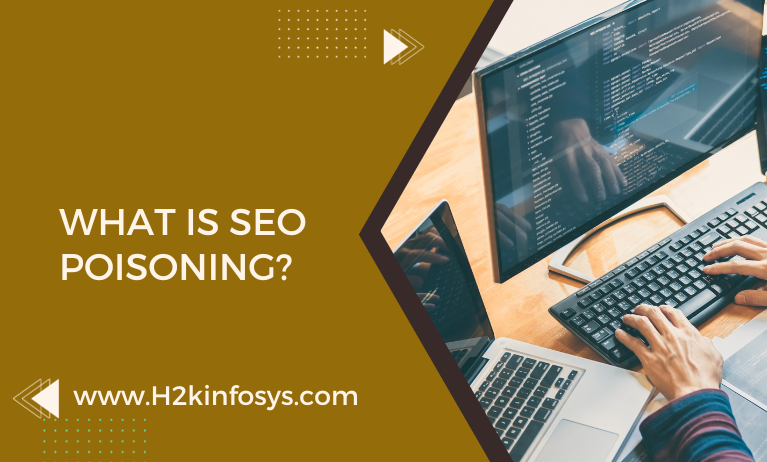The term “search engine optimization” (SEO) refers to techniques used to raise a website’s SEO Poisoning in a search engine’s results page. Every major search engine, including Google, Bing, and others, uses an algorithm to choose which websites appear at the top of a user’s search results and which are relegated to pages two and below.
As more people utilise search engines than ever before, harmful advertising (malvertising) and search engine optimization (SEO) poisoning have both greatly increased. While SEO poisoning can have an impact on both individuals and businesses, many are not aware of the security risk it presents.
This article will examine SEO poisoning, including its causes, methods of detection and prevention, and remedies. You can learn more by checking out the cyber security online course.
Threat actors utilise the tactic of “SEO poisoning” to make their malicious websites more visible and appear more trustworthy to consumers. SEO poisoning is particularly successful when people don’t carefully examine their search results since it deceives people into thinking that the top results are the most reliable. This may result in malware infestations, credential theft, and financial losses.
Threat actors may also utilise spear-phishing and other targeted SEO poisoning techniques to target specific individuals, such as IT administrators. Attackers can target and tailor their attacks to certain audiences using this strategy, making them harder to detect and defend against.
Black-hat SEO strategies called “SEO poisoning” are used to promote harmful websites by exploiting these search engine algorithms. Users are more likely to trust and visit a website if the attacker can design their web page to rank well on Google or Bing. As a result, the attacker is able to spread malware or other harmful content on these websites.
How SEO Poisoning Works
Several elements, including the use of keywords and backlinks, are used by SEO algorithms to rank web pages. These malicious sites may target keywords that their targets are likely to look for in order to target particular sectors or users. Additionally, attackers might employ strategies like typosquatting to resemble well-known websites that the targeted are likely to visit. Finally, hackers may employ unethical black-hat SEO techniques to increase a page’s ranking in a search engine’s results.
An attacker’s objective is to persuade a user to download and install a file after dumping them into visiting the website. Attackers utilise a variety of deceptive strategies to disguise their malware as phoney games, office programs, and other helpful tools. To make the fraud more plausible, these trojans will include false icons and possibly even a genuine copy of the software.
Examples of SEO poisoning
Attacks using SEO poisoning are carried out by numerous cyber threat actors and technologies. Several instances include:
- Gootloader: Uses visual overlays and SEO poisoning to deceive targets.
- BATLoader: Targets may be sent to phoney message boards by SEO poisoning efforts using BATLoader.
- Solarmarker: Attempts to deceive remote employees into downloading phoney PDF files.
Recent SEO Poisoning Campaigns
Numerous instances of bogus installers being pushed through malicious advertising or SEO poisoning occurred in January 2023. Hackers dropped Python-based malware that could collect data like browser passwords and cryptocurrency wallets using poisoned Google Ads.
Criminals continue to use fake installers and SEO poisoning to spread malware. Recent occurrences, for instance, involved phoney OBS Studio or Notepad++ instals that loaded malware to steal private data.
How to Detect SEO Poisoning
Various techniques are used in SEO poisoning attacks to deceive consumers into visiting their websites. These are a few ways to recognize these attacks:
- Keep an eye out for typosquatting domains that imitate authentic websites.
- To find known bad URLs connected to SEO poisoning attacks, use threat intelligence.
- Make use of endpoint detection and response (EDR) tools to spot malware that was distributed through SEO poisoning attempts.
- Keep an eye out for attempts to run programs from a ZIP archive.
How to Prevent SEO Poisoning
Organisations can take precautions against these attacks in addition to keeping an eye out for SEO poisoning. Among the finest practices are:
- Employee Education: Inform staff members about Internet application download dangers and SEO poisoning attacks. Teach your staff to recognize typosquatting domains.
- Web security: Use web security technologies to find websites hosting harmful information and to shield users from overlays, redirections, and other techniques that could lead them to access harmful content.
- Endpoint Security: To detect and prevent attempted malware infections caused by SEO poisoning campaigns, use endpoint security solutions like an endpoint protection platform (EPP).
- Patch Management: Maintaining updated business systems and browsers will stop harmful websites from making use of unpatched vulnerabilities.
Conclusion
SEO poisoning attacks are becoming more common and are a severe danger to the cybersecurity of a company. Limiting organizational cyber risk requires defence against these and similar malware-delivery attacks. Check out the online cyber security training to learn more.






























